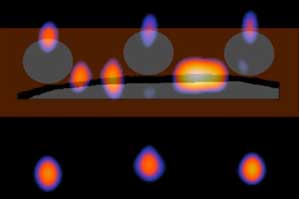Radio waves for crowd protection

 The death toll in Jos, Nigeria after the most recent suicide bomb has climbed to 19. In our jaded world, that doesn’t seem so high. But nearly 13,000 individuals died from suicide attacks between 2003 and 2010, and clearly that number continues to rise.
The death toll in Jos, Nigeria after the most recent suicide bomb has climbed to 19. In our jaded world, that doesn’t seem so high. But nearly 13,000 individuals died from suicide attacks between 2003 and 2010, and clearly that number continues to rise.
Professors Carey Rappaport and Jose Martinez are using their skills in electromagnetic radiation to put an end to that.
In a recent paper, the duo presented a first-of-its-kind standoff detection system for identifying suicide bombers in a crowd. The imaging technique uses millimeter (mm) wave radiation (the shortest wavelength in the radio wave frequency range) to distinguish between different material types. The electromagnetic wave, Martinez explained, propagates at different speeds when it travels through air, the human body, or an explosive material.
They can assign a characteristic speed to these different materials, thereby detecting not only the fact that an anomalous object is present under a person’s clothing, but also what it’s made out of.
Rappaport reminded me of the harsh reality that a suicide bomber would not be satisfied merely with a bag of explosives taped to his/her body. Nails and other metal objects, once shot through a crowd, could do much more damage at further distances. So, being able to distinguish between material types could be quite valuable.
In the image above, the black line represents the front of a human body and the gray circles represent images of metal rods taped to the stomach. The colored circles are SAR (Synthetic Aperture Radar) images of wax bars, through which the mm wave propagates at a similar speed as through TNT. At first their location seemingly inside the body confused the team, until they realized what was happening. It was their first clue about the speed differences.
Waves that must first penetrate wax (or TNT) before reaching the body and ultimately the detector, slow down sufficiently so that compared to waves that did not pass through wax, they look farther removed from the surface.
In order to use this technique in a crowd setting, the team developed an array of mm wave radar devices and detectors that can be stationed throughout an area one wishes to secure. As people pass by the radars, the array collects a series of data that, when taken together, can identify a metal or explosive anomaly.





